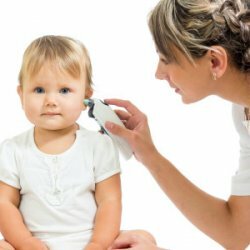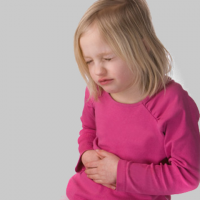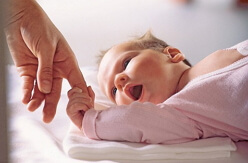Otitis pri otroku: vzroki za razvoj, simptome in zdravljenje
 Children get sick very often. And the disease can be very diverse. Most often, infants are ill with SARS, influenza and nasopharyngeal diseases. Therefore, at least once, every mother heard complaints of the child that his ear hurts. Almost always the cause of these pains is otitis.
Children get sick very often. And the disease can be very diverse. Most often, infants are ill with SARS, influenza and nasopharyngeal diseases. Therefore, at least once, every mother heard complaints of the child that his ear hurts. Almost always the cause of these pains is otitis.
Otitis is an inflammation of the ear canal, which can occur in acute and chronic forms. With this disease, purulent contents accumulate in the middle ear cavity. Otitis often affects children. The age of children is different - from infancy to school. This fact is explained by the anatomical features of the structure of the middle ear in children. The younger the baby, the shorter his ear tube, which is almost entirely straight and without bends. Because of this structure, the infection penetrates into the ear canal without any obstacles. As the baby grows, its predisposition to this disease decreases. And already in adolescence, a person does not get otitis. However, many studies show that 80% of all children, before the age of three, had otitis at least once.
Causes of the disease
As a rule, the inflammation of the ear canal begins after the infection gets into it. Most often, otitis develops after various colds and after acute respiratory infections. Much less common are otitis media, which occur with ear trauma or with severe allergies. Let's take a closer look at the reasons why otitis can occur:
- Acute respiratory infections affect the mucous membranes of the nose and provoke clogging of the opening of the auditory tube. Because of this blockage, natural processes in the ear are violated: the process of draining the tympanum and the process of ventilation.
- Infection in the middle ear. In the cavity of the middle ear, the infection enters through the ear canal.
- Adenoids, swollen nasopharynx, purulent sinusitis and tonsillitis.
- Sharp pressure drops.
- Impaired immune system.
Symptoms of the disease
Symptoms of this disease are very typical, so the doctor without problems will recognize the disease. The only sign on which you can suspect otitis in a child under the age of one is a strong crying and anxiety of the baby. In such cases it is necessary to conduct the next test - the doctor with the index finger slightly presses on the aperture of the ear canal. If the crying and anxiety of the baby intensify, the doctor has every reason to believe that otitis has a crumb.
In all other cases, otitis can be determined by such symptoms:
- very intense pain in the ear, with the pain shooting;
- severe dizziness and headaches;
- hearing loss, sometimes severe;
- increase in body temperature( sometimes up to 40 degrees).
If parents notice such symptoms from their baby, it should be taken to the hospital as soon as possible and the ENT is indicated to the doctor. Doctors distinguish three main types of the course of the disease: chronic, acute and protracted otitis media. If the correct diagnosis is established in time and the treatment is started, the acute stage of the disease will last no more than three days. Then the symptoms will go down and in a week or one and a half the child will be completely healthy.
If the disease is not found at the time and the timely treatment is not started, then the duration of the disease will increase significantly. In addition, the otitis will go into a protracted form. With prolonged form, the symptoms can last about a week and only after 10 days will complete full recovery.
The third form, chronic, arises in the event that the disease will then appear, then disappear periodically. Chronic otitis can occur if there is no proper treatment or if the immune system of the child is very much weakened. Treatment of the chronic form of the disease should be comprehensive.
Possible complications after otitis
Most often the child is very difficult to tolerate otitis, but despite this, serious complications are very rare. However, there are exceptions. After otitis media, diseases such as meningitis and encephalitis can develop. Inflammation of the mastoid process is also possible.
The fact that the disease has caused such complications can be guessed from the high temperature, as well as the deterioration of the general condition of the child. In addition, parents should be alerted if pus from the ear continues to stand out for two weeks - this is also one of the symptoms of a complication after otitis.
Treatment of otitis
As mentioned above, otitis is a serious disease that can lead to serious complications if left untreated. However, it should be understood that only the folk remedies to treat otitis in a child is definitely not worth it. Treatment should be prescribed only by a doctor. The treatment regimen is selected individually, depending on the severity of the disease, the form of its course and the presence or absence of other diseases. Also, when choosing a treatment, the age of the child and his individual characteristics of the organism are taken into account.
Treatment scheme consists of two main stages:
Reduction of pain intensity
The first thing that needs to be done is to reduce pain. The thing is that the pain in otitis is so strong that the child is completely deprived of rest, he can neither sleep nor eat. To reduce the intensity of pain, doctors prescribe the baby drugs that contain paracetamol. But be careful, these drugs must necessarily be for children, drugs for adults, the child can not be given. In addition, the doctor prescribes ear drops. Drops are selected by the age of the baby, as well as by his individual characteristics.
Complementary to medical treatment can be used compresses that effectively eliminate pain. To make such a compress, buy a pharmacy 3% solution of boric acid, sterile gauze and glycerin. Thoroughly mix boric acid with glycerin, and from the gauze make a swab that fits in the ear canal of the baby. Then, moisten the tampon in the resulting mixture and add it to the child's ear passage.
No less effective and warming compress. Make of a cotton cloth a small pouch, the size of a matchbox. Then take ordinary large table salt and heat it in a frying pan. Place the hot salt in a bag and cool to a temperature that will be comfort for the child. This pouch must be applied to the sick ear, and cover the top with a layer of cotton wool and fix it with a bandage. Compress should be on the ear of the crumb until it completely cools. Such compresses are absolutely safe and they do not have any contraindications or side effects.
Elimination of puffiness
In order to ensure the outflow of pus from the middle ear, it is necessary to eliminate the swelling of the auditory tube. To do this, the doctor prescribes the child vasoconstrictor drops in the nose. If the otitis appeared against the background of an allergic reaction, then the doctor will prescribe antihistamines to eliminate puffiness.
Remember that you can not choose your own preparations for your child. This should be done only by a doctor. Any drug is prescribed based on the individual characteristics of the baby. In addition, many drugs for children are very dangerous, as they can cause a number of serious side effects.



